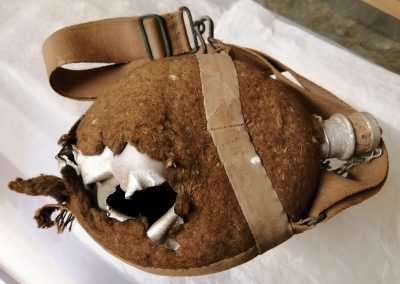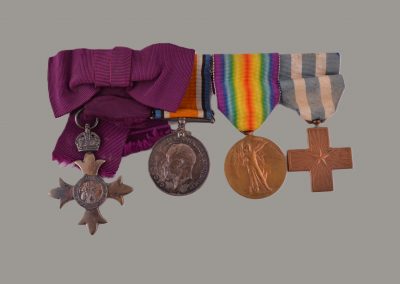The Bombardment of Whitby, by William Scott Hodgson
Pannett Art Gallery
When William Scott Hodgson (1864-1925) painted this maritime scene around the year 1918, the events would have undoubtedly still been in the minds of the people of Whitby.
The painting depicts a real historic event from the early months of the First World War, when, on the 16th December, 1914, German warships travelled down the east coast bombarding the towns of Hartlepool, Whitby and Scarborough.
The attack was a surprise and the towns Scarborough and Whitby were undefended. First hand accounts from the bombardment say the morning was misty and foggy and so visibility was poor. You can explore how the attack on Scarborough was viewed in more detail elsewhere on the site.
Exploring the artist’s approach
William Scott Hodgson is known for painting naval and maritime scenes, especially of Whitby and the Yorkshire coast, but this oil on canvas takes an unusual perspective. The viewer observes the scene from the sea not the land, with the dark, threatening outline of the battleship in the foreground, which is perhaps disproportionately large compared to the cliffs to the right.
Hodgson has used a grey palette for this painting which helps to convey this kind of murky weather and confusion.
The rough brushstrokes used for the sea and air help to create a sense of movement. There is also a smudge of paint just to the right of the ship which is suggestive of a missile having just been fired. Splashes of white paint near the coastline also suggest missiles or debris crashing into the water.
The painting is in oil on canvas and measures 75.1cm (H) x 125.9 cm (W).
The Rowing Boat by William Scott Hodgson
Pannett Art Gallery
You can get more of a sense of William Scott Hodgson’s style by considering another painting. ‘The Rowing Boat’ depicts people trying to navigate in rough seas. The angle of the boat with the rear end tipped up high helps to convey how rough and high the waves are.
You can see how Hodgson has used the rough brush strokes here, as in ‘The Bombardment of Whitby’, to create a sense of movement. The bleakness of the sea, sky and weather is suggested again by the grey-brown palette.
Talking Points
Explore ‘The Bombardment of Whitby’
What colours has Hodgson used? Do you think his choice of colour palette is effective? Why?
Why do you think Hodgson decided to set the perspective of the viewer from the sea?
Do you think that the warship has been painted in correct proportion to the cliff? What sort of effect do you think Hodgson was trying to create?

Talking Points
‘The Rowing Boat’
How has Hodgson made the water appear to be moving?
Do any of his colours surprise you?
‘Composition’ in painting refers to how the different parts of the overall image relate to each other. Where are the ship, the coastline, the people, the sky? Why might Hodgson have arranged them this way?
What do you think the people in the boat are doing? Why might they be out in rough seas in a rowboat? What could the person at the front be pointing at?

Vocabulary
Bombardment: A continuous attack with bombs, shells or other missiles
Composition: The way the different elements or parts of a work of art have been organised
Proportion: the relationship between the sizes of different elements of a composition. By distorting proportions, artists are able to create different effects, for example using it to create feelings of strength, weakness or mystery.
In the Classroom
Short drama activity
In groups of 3 or 4, create a montage or freeze frame based on the scene in the rowing boat. Think about how you could use height and levels to recreate the scene. You could use a thought-tracking activity to find out what the characters are thinking.

Hands on History
You can see more seascapes and maritime paintings of the North Yorkshire Coast on permanent display at Pannett Art Gallery in Whitby.
You can borrow a World War One loan box from Scarborough Museums and Galleries, designed to help you discover more about the bombardment in along the North Yorkshire Coast
Elsewhere in North Yorkshire loan boxes are also available from Beck Isle Museum in Pickering and from The Dales Countryside Museum in Hawes.
Scarborough Museums and Galleries also offers a creative workshop on the theme of World War One and its impact on the people of Scarborough.
Museum Location
Explore a range of objects from the First World War









